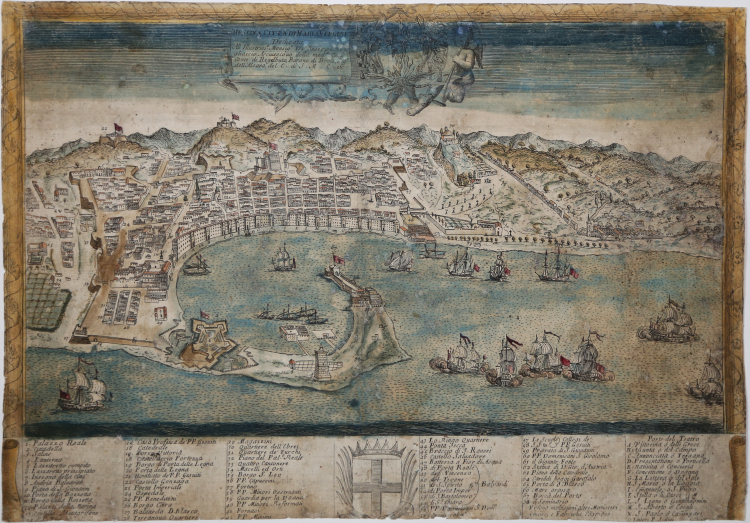



| Reference: | S41909 |
| Author | Paolo PETRINI |
| Year: | 1698 ca. |
| Zone: | Messina |
| Measures: | 430 x 300 mm |


| Reference: | S41909 |
| Author | Paolo PETRINI |
| Year: | 1698 ca. |
| Zone: | Messina |
| Measures: | 430 x 300 mm |
Beautiful proof, printed on contemporary laid paper, irregularly trimmed at the copperplate without the ornamental frame at the bottom, abrasions and restorations to the verso and recto, otherwise in good condition.
In the cartouche at the top we find the title and dedication: Messina Città di Maria Vergine Dedicata all’Illustriss.o Monsig.r D. Giuseppe Migliaccio Arcivescovo della med.a Città Conte di Regalbuto, Barone di Broli e Sig.r dell’Alcara del C. di S. M. C. etc.
The view realized between the end of the seventeenth century and the beginning of the eighteenth century, it will represent in way still more detailed the new urban order. The plant, realized by an anonymous engraver, results of invoice very similar to that of Palermo engraved by Paolo Petrini. The city is represented by the usual point of observation even if this time. in the changed historical context, lacks the detailed reproduction of the Calabrian coast. As in the view of Palermo, more than the drawing are the areas of text to "draw" the laudatio cartographica of the "new" city. The title, Messina city of Virgin Mary, reiterates the close link with the Marian cult, while the dedication to Giuseppe Migliaccio, archbishop of the city from 1698 to 1729, would seem to reveal the commissioning of the work. Even here, however, it is the long legend (68 references) that, reiterating and updating the characteristics of the sixteenth-century views, gives contour to the urban phenomenon. The first reference is to the Royal Palace, as if to underline the not yet dormant ambition of Messina's supremacy. To this they follow the principal urban emergencies, from the Lantern to the Lazzaretti, from the Cathedral to the Neighborhoods dci Turks and of the Hebrews, from the Arm of S. Ranieri to the Archbishopric, to the Statue of D. Giovanni of Austria and to the Mouth of the Port. The religious element - in line with the dedication - is particularly present, as well as the reference to the fortified city, its castles and bastions. But what stands out in the plan is the Maritime Theater, almost out of scale in relation to the other urban buildings. A highlight that, in the legend, is underlined by the list of the eighteen Gates of the Theater, indicated, in a different way, with the letters from A to S. The general characteristics of the imago Urbis of Messina, therefore, do not change much with respect to the 16th century plans, but the substitution of the walls with the elegant succession of 17th century palaces stands out (cf. Militello, Portraits of cities in Sicily and Malta: 16th-17th century, p. 62).
This rare view of Messina, attributed to Paolo Petrini, is probably made in 1698, the year of the appointment of Giuseppe Migliaccio as Archbishop of the city.
Literature
Paolo Militello, Pietro Militello, Ritratti di città in Sicilia e a Malta: XVI-XVII secolo, p. 62, fig. 34.
Paolo PETRINI (Attivo a Napoli fine del XVIII secolo)
|
very little is known about Petrini except that for many years he was a publisher and map seller in Naples producine large and small maps often slavishly based on those by Guillaume Sanson and Nicolas de Fer. About 1718 he published a large-scale plan of Naples. All his work is very rare.
1700 Atlante Partenopea
1700 Mappa Mondo Vero Carta
1700 ca. Maps of the wolrd and continents (wall maps)
|
Paolo PETRINI (Attivo a Napoli fine del XVIII secolo)
|
very little is known about Petrini except that for many years he was a publisher and map seller in Naples producine large and small maps often slavishly based on those by Guillaume Sanson and Nicolas de Fer. About 1718 he published a large-scale plan of Naples. All his work is very rare.
1700 Atlante Partenopea
1700 Mappa Mondo Vero Carta
1700 ca. Maps of the wolrd and continents (wall maps)
|